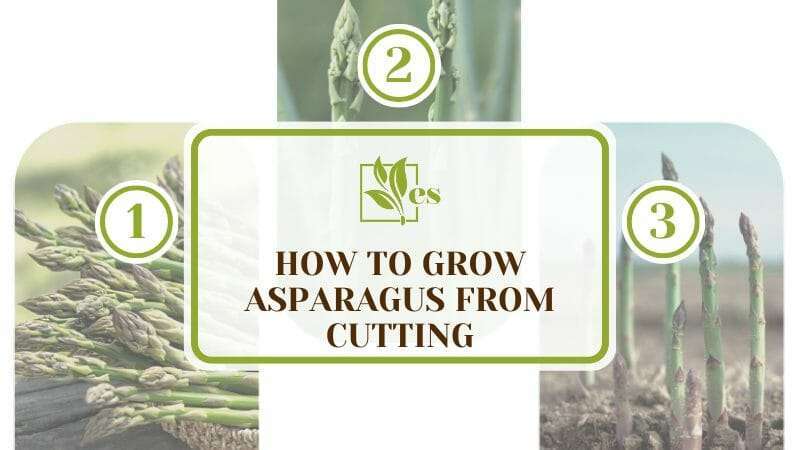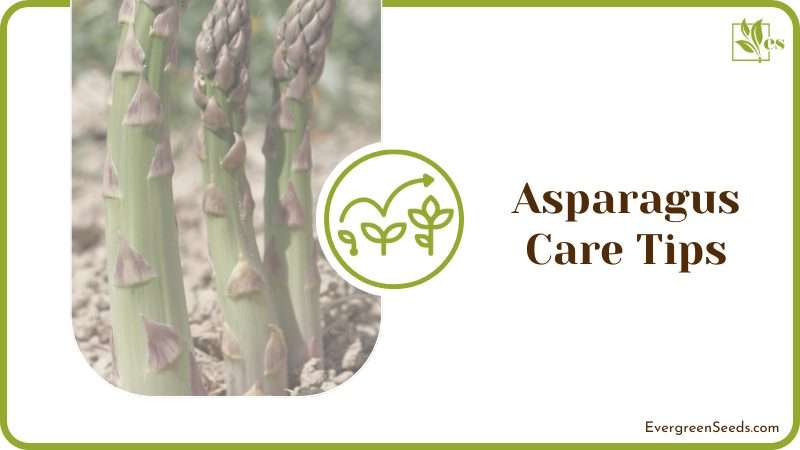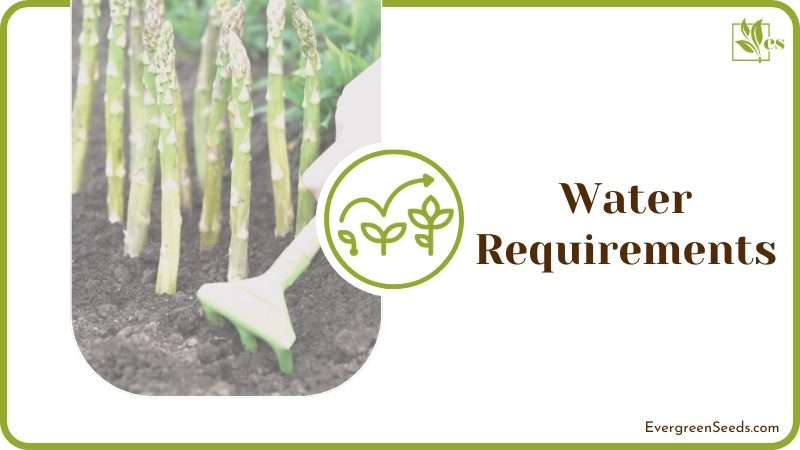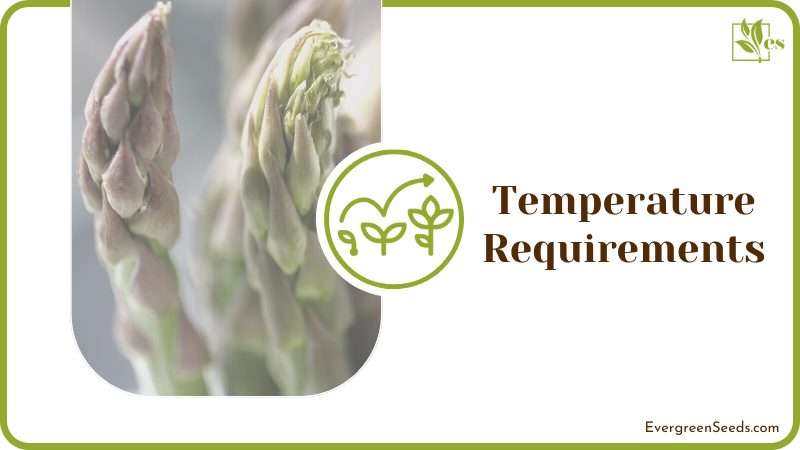Learning to grow asparagus from cuttings is very important as it can save you a lot of time and money. You do not need to go to the store whenever you need asparagus leaves.

Also, growing asparagus from seeds is time-consuming. In this article, we’ll tell you everything you need to know to propagate asparagus from cuttings.
JUMP TO TOPIC
How To Grow Asparagus From Cuttings
Why throw away your kitchen scraps when you can grow asparagus from scraps? There are two major ways to do this. Let us discuss the common methods of asparagus propagation.
-
Soil Method
The soil method of propagating asparagus from cutting is the most natural. It is also the easiest and is supported by many soil types. Follow these simple steps to do this successfully:
- Get your cuttings: Your asparagus cuttings should come from a fresh asparagus plant. Do not use cuttings from the fridge or freezer.
- Wash your cuttings: You do not want dirt around your cuttings when planting them as dirt can attract harmful microbes.
- Cut the top of your cuttings: You need at least 6 inches of cutting to grow asparagus. If your cutting has roots at the bottom, do not cut them away.
- Wet the soil: Even though you will water your cuttings later, you want the soil to be moderately moist. It should not be soggy.
- Plant your cuttings: Bury the bottom side of your cutting on the ground. Around two to three inches of cutting can go below the soil surface.
- Water your cuttings by misting: Mist the cutting regularly. If you want to pour water on the soil, make sure that you do it gently so that you do not displace the cuttings.
- Check for growth: When done properly, you should notice a new leaf growing from the middle of the cutting in less than 2 weeks.
If your asparagus plant does not grow, gently remove it from the soil and check for roots. The plant should already be decaying if it is not healthy.
-
Water Method
The water method of growing asparagus from cuttings is fun and you also get to see the progress of your plant’s growth. To grow your asparagus from cutting with water, follow the steps below:
- Get and wash your asparagus cuttings. Wash them before putting them in a glass of water.
- Fill a glass of water with clean water. You can use a jar or any clear container.
- Put your asparagus cuttings in the water. Do not cover the entire cutting in water; about 2/3 of the cutting should be above water.
- Always change the water. If you notice that the water is becoming green or slimy, remove it and pour in clean water.
- Observe your cuttings for growth. In less than a week, you should see roots growing from the base of your cuttings. You should also notice a new leaf growth in less than two weeks.
- Rinse and plant your cuttings. When there are enough roots and you have at least a pair of leaves, you can plant your cutting in your preferred substrate. People who start asparagus in water usually grow them in hydroponics and aquaponics tanks.
What is your preferred method of growing asparagus cuttings? Want more tips to grow your asparagus cuttings? We’ll tackle some more helpful tips and tricks in the next section.
Extra Tips for Growing Asparagus From Cutting
Here are some useful tips to grow asparagus cuttings:
- Start your cuttings indoors. You need to start your cuttings indoors when you are using the water method so that you can prevent wind from reaching it. You can also start your cuttings in soil indoors before spring so that you can simply transplant them later.
- Use a rooting hormone. To encourage the quick development of roots in your asparagus, you should consider dipping the cutting into a rooting hormone before planting it in the soil.
- Keep the soil dry if your cuttings continue to rot. If you consistently notice that your asparagus cuttings are rotting in the soil method, you should water them by misting and keep the soil dry until they start growing again.
Asparagus Care Tips: Make Sure That You Are Doing It Right
Since you already know how to propagate your asparagus plants, it is time to learn the basic care tips of asparagus. Take note that this plant is very easy to care for, so you do not have to worry about it too much as long as you grow it in the right conditions.

– Soil or Potting Mix for Asparagus
The substrate you grow your asparagus in is very important. Asparagus plants cannot grow well in soil that can suffocate them. Your asparagus substrate should be well-drained and retain just a little moisture.
Asparagus plants grow best in soil pH levels of 6.5 to 7. This means that they prefer slightly acidic soil but can tolerate neutral soil. The substrate should be free from weeds, pests and diseases.
If you are growing your asparagus plants in pots, make sure that the pot is 2-5 inches wider than your asparagus plant to permit the plant to spread while growing. Also, the pot should have multiple drainage holes to help water drain quickly.
As a tip, the best way to grow asparagus is to grow it in pots or raised garden beds as you can easily amend the soil and even change it if needed.
– Asparagus Light and Humidity Requirements
Just like many other plants, asparagus plants love full sun. This means that your asparagus should have six or more hours of sunlight per day. They can also tolerate partial shade, but take note that they will not grow as big and healthy as plants growing in full sun.
When selecting a suitable place to grow your plants, look for the south-facing parts of your garden as they receive the best amount of sunlight daily. If you are growing your asparagus in pots indoors, grow them on a windowsill, preferably on the south-facing windowsill.
Asparagus can tolerate a wide range of humidity. You can grow them in 50 to 75 percent humidity, and if you feel that the atmosphere is arid, you can quickly mist water droplets on the leaves of your asparagus. Do not mist the asparagus plants too much that their leaves drip water.
– Water Requirements
Asparagus plants have no unique water needs. Water your plants regularly and do not wait until the soil is dry before you water them again.

Make sure that the soil is consistently moist but not soggy. Your asparagus will grow healthier and larger when the soil is well-drained and consistently moist.
If you are growing your plants in a raised garden bed, you should pay attention to their water needs as water drains quickly in these settings. Make sure that the surface of your garden bed soil is moist.
Underwatering
Some ways to tell that your asparagus plants need water are:
- They are drying out.
- Their leaves are turning yellow.
- The water in the soil dries out quicker than normal.
Overwatering
If you are overwatering your asparagus plants, you will know with the following signs:
- Root rot: When your asparagus plants start decaying from the inside, you need to reduce your watering rate.
- Dropping leaves: Overwatering can kill the leaves of your asparagus plants. They might also turn brown.
Make sure that you water your asparagus plants with just the right amount of water.
– Nutrient Requirements
Asparagus plants are heavy feeders. They will consume a lot of fertilizer, so you can save costs by enriching the soil with organic matter such as compost, organic fertilizer, rotted manure, etc. You should top-dress the substrate every year so that your asparagus plants can have enough nutrients.
Take note that your plants feed more during the spring and summer months, so you need to make sure that there are enough nutrients in the soil by then. You should use a fertilizer with a high nitrogen concentration to encourage the growth of fresh green asparagus leaves.
Under-fertilizing
Some ways to tell that your asparagus plants need extra nutrients are:
- Chlorosis: Chlorosis occurs when your asparagus leaves lose their green color. Asparagus plants need nitrogen and other nutrients to produce green leaves.
- Stunted growth: When your plants do not have enough nutrients, they will not grow as big as plants with nutrients even if you grow them in the right conditions.
- Plants dying: When you still do not enrich your soil, your plants will start dying.
Over-fertilizing
Some ways to tell that your plants have more than enough nutrients are:
- Burning leaves: If the nutrients in the soil are too much, your plant leaves will dry out and the tips will become brown. This is because water is leaving the leaves to go to the roots.
- Weak plant in the day, strong at night: Plants collect more water in the day and more nutrients at night. If the sun is hot and there are more nutrients than water in the soil, your asparagus cannot receive as much water as it needs and it will become weak during the day.
- Plants dying: If you do not amend your soil to reduce the nutrients in it, your plants will die.
Make sure that you feed your asparagus with just the right amount of nutrients.
– Temperature Requirements
Asparagus plants (according to the variety) can tolerate a wide range of temperatures. You can grow asparagus in USDA hardiness zones 2-11. Even though the plant has a wide temperature tolerance range, the optimum temperature to grow the healthiest asparagus is between 70 and 85 degrees Fahrenheit.

Can you overwinter and replant asparagus? It depends on your USDA hardiness zone. If you live in warmer regions (10-11), you can grow asparagus as a perennial plant. For places that experience frost, you need to overwinter your asparagus.
Wait until the plant is turning brown in fall (approaching winter) and cut off the upper parts of the plant. Cover the stump in the ground with compost and other organic matter. During spring, the stump will grow back.
Remember that you can grow asparagus from spears, so you do not have to dispose of the cuttings.
– Harvesting Your Asparagus
You should wait until your asparagus plants are three years old before you start harvesting them. You can harvest up to 5-7 inches of asparagus spears. You should only harvest them for at most four weeks in their third year so that they can have enough leaves to survive.
When they are six years or older, you can harvest them for as much as six weeks per year. More plants will spread from your already existing asparagus, so you can easily get more plants to harvest from.
Problems When Growing Asparagus
Asparagus plants are easy to grow and you can solve every asparagus-related problem you encounter. Just watch out for the following:
– Pests
Watch out for pests such as asparagus beetles and aphids when growing asparagus. Asparagus beetles can destroy your plants by damaging the leaves and other parts. Fusarium wilt can also attack your asparagus plants.
For insect pests, you can use neem oil to repel them. You can also use pesticides, but remember that these can also kill and damage your plants.
– Root Rot
Several fungi species are responsible for root rot in asparagus. While these fungi are regularly in soil, they only attack weak and dying plants. The most common situation where decomposing fungi attack your asparagus is when you overwater the plants.

Overwatering your asparagus can kill their roots through suffocation. As more roots die, root rot attacks the plant. To prevent root rot in your asparagus plants, do not overwater your plants and prune off dead leaves so that they do not decay close to the plant.
– Leggy Stems
If your asparagus plants are taller than normal and they have weak stems and leaves, they have a light deficiency. You should give them access to more sunlight so they can grow strong and have enough leaves.











